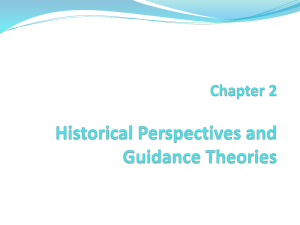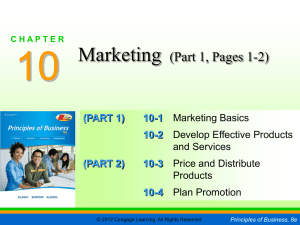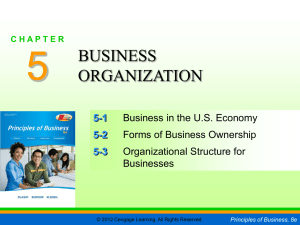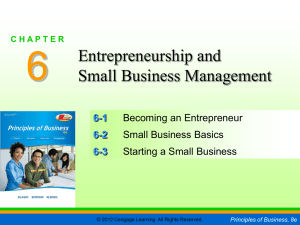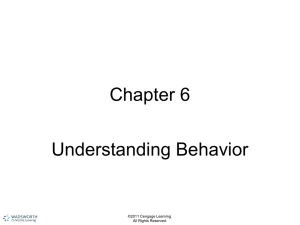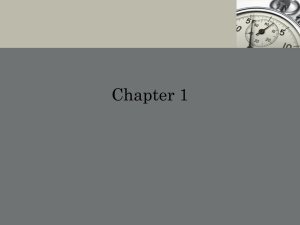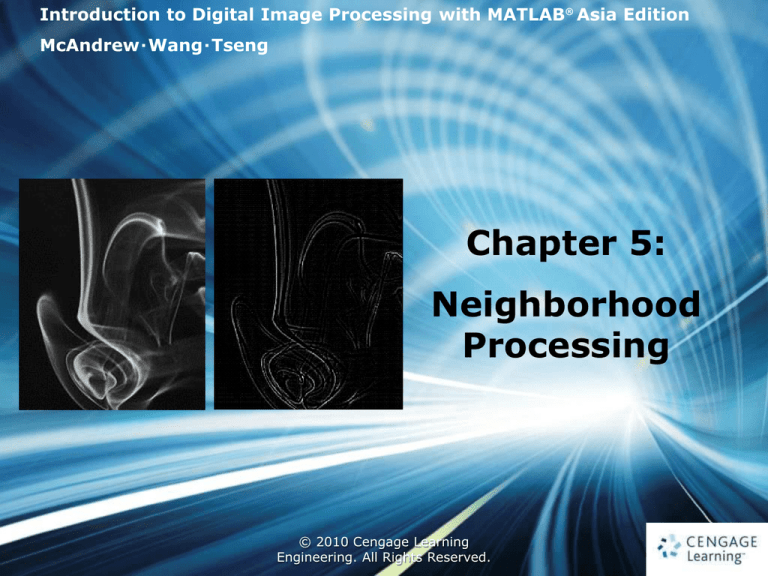
Introduction to Digital Image Processing with MATLAB® Asia Edition
McAndrew‧Wang‧Tseng
Chapter 5:
Neighborhood
Processing
1
© 2010 Cengage Learning
Engineering. All Rights Reserved.
1
5.1 Introduction
• Move a mask
A rectangle (usually with sides of odd length) or
other shape over the given image
2
Ch5-p.87
© 2010 Cengage Learning
Engineering. All Rights Reserved.
5.1 Introduction
• Mask values
3
Ch5-p.88
© 2010 Cengage Learning
Engineering. All Rights Reserved.
5.1 Introduction
• Corresponding pixel values
4
Ch5-p.88
© 2010 Cengage Learning
Engineering. All Rights Reserved.
FIGURE 5.2
5
Ch5-p.89
© 2010 Cengage Learning
Engineering. All Rights Reserved.
5.1 Introduction
• Allied to spatial filtering is spatial convolution
The filter must be rotated by 180° before multiplying
and adding
6
Ch5-p.89
© 2010 Cengage Learning
Engineering. All Rights Reserved.
5.1 Introduction
• EXAMPLE One important linear filter is to use a
3×3 mask and take the average of all nine values
within the mask
7
Ch5-p.90
© 2010 Cengage Learning
Engineering. All Rights Reserved.
5.1 Introduction
The result of filtering x with 3×3 averaging filter
8
Ch5-p.90
© 2010 Cengage Learning
Engineering. All Rights Reserved.
5.2 Notation
• It is convenient to describe a linear filter simply
in terms of the coefficients of all the gray values
of pixels within the mask
The averaging filter
9
Ch5-p.91-92
© 2010 Cengage Learning
Engineering. All Rights Reserved.
5.2 Notation
EXAMPLE The filter
would operate on gray values as
10
Ch5-p.92
© 2010 Cengage Learning
Engineering. All Rights Reserved.
5.2.1 Edges of the Image
• What happens at the edge of the image, where
the mask partly falls outside the image?
• There are a number of different approaches to
dealing with this problem
11
Ch5-p.92
© 2010 Cengage Learning
Engineering. All Rights Reserved.
5.2.1 Edges of the Image
• Ignore the edges
• Pad with zeros
0 0 0 0 0 0 0 0 0 0 0 0 0
0
0
0
0
0
0
0
0
0
0
0
0
0 0 0 0 0 0 0 0 0 0 0 0 0
12
Ch5-p.92
© 2010 Cengage Learning
Engineering. All Rights Reserved.
5.2.1 Edges of the Image
• Mirroring
2
2
3
4
5
6
7
7
13
Ch5-p.93
2
2
3
4
5
6
7
7
3 4 5 4 3 2 1 2 3 4 4
3 4 5 4 3 2 1 2 3 4 4
3 3
4 4
5 5
6 6
6 5 4 3 2 1 2 3 4 5 5
6 5 4 3 2 1 2 3 4 5 5
© 2010 Cengage Learning
Engineering. All Rights Reserved.
5.3 Filtering in MATLAB
• filter2 function
the result is a matrix of data type double!!
• shape is optional; it describes the method for
dealing with the edges
‘same’-pad with zeros
‘valid’-ignore the edges
14
Ch5-p.93
© 2010 Cengage Learning
Engineering. All Rights Reserved.
5.3 Filtering in MATLAB
15
Ch5-p.93
© 2010 Cengage Learning
Engineering. All Rights Reserved.
5.3 Filtering in MATLAB
16
Ch5-p.94
© 2010 Cengage Learning
Engineering. All Rights Reserved.
5.3 Filtering in MATLAB
• The result of ’same’ may also be obtained by
padding with zeros and using ’valid’:
17
Ch5-p.94
© 2010 Cengage Learning
Engineering. All Rights Reserved.
5.3 Filtering in MATLAB
• filter2(filter,image,’full’)
returns a result larger than the original
• It does this by padding with zero and applying
the filter at all places on and around the image
where the mask intersects the image matrix
18
Ch5-p.94
© 2010 Cengage Learning
Engineering. All Rights Reserved.
5.3 Filtering in MATLAB
19
Ch5-p.94
© 2010 Cengage Learning
Engineering. All Rights Reserved.
5.3 Filtering in MATLAB
• filter2 provides no mirroring option
• The mirroring approach can be realized by
placing the following codes before filter2
(filter,image,’valid’)
20
Ch5-p.95
© 2010 Cengage Learning
Engineering. All Rights Reserved.
5.3 Filtering in MATLAB
• Where matrix x is extended to m_x, wr/wc is
defined as one half total column/row number of
the mask (chopping the decimal)
21
Ch5-p.95
© 2010 Cengage Learning
Engineering. All Rights Reserved.
5.3 Filtering in MATLAB
• fspecial function
h = fspecial(type, parameters)
>>imshow(uint8(cf1))
or
>>imshow(cf1/255)
22
Ch5-p.95
© 2010 Cengage Learning
Engineering. All Rights Reserved.
FIGURE 5.4
23
Ch5-p.97
© 2010 Cengage Learning
Engineering. All Rights Reserved.
5.4 Frequencies: Low- and High-Pass Filters
• Frequencies of an image are a measure of the
amount by which gray values change with
distance
high-pass filter
low-pass filter
24
Ch5-p.98
© 2010 Cengage Learning
Engineering. All Rights Reserved.
5.4 Frequencies: Low- and High-Pass Filters
25
Ch5-p.99
© 2010 Cengage Learning
Engineering. All Rights Reserved.
FIGURE 5.5
26
Ch5-p.100
© 2010 Cengage Learning
Engineering. All Rights Reserved.
5.4 Frequencies: Low- and High-Pass Filters
• VALUES OUTSIDE THE RANGE 0–255
Make negative values positive
Clip values
27
Ch5-p.100
© 2010 Cengage Learning
Engineering. All Rights Reserved.
5.4 Frequencies: Low- and High-Pass Filters
0-255 Scaling transformation (uint8)
28
Ch5-p.101
© 2010 Cengage Learning
Engineering. All Rights Reserved.
5.4 Frequencies: Low- and High-Pass Filters
0-1 Scaling transformation (double)
29
Ch5-p.101-102
© 2010 Cengage Learning
Engineering. All Rights Reserved.
FIGURE 5.6
30
Ch5-p.102
© 2010 Cengage Learning
Engineering. All Rights Reserved.
5.5 Gaussian Filters
31
Ch5-p.103
© 2010 Cengage Learning
Engineering. All Rights Reserved.
FIGURE 5.8
32
Ch5-p.104
© 2010 Cengage Learning
Engineering. All Rights Reserved.
5.5 Gaussian Filters
33
Ch5-p.104
© 2010 Cengage Learning
Engineering. All Rights Reserved.
FIGURE 5.9
34
Ch5-p.105
© 2010 Cengage Learning
Engineering. All Rights Reserved.
5.6 Edge Sharpening
• 5.6.1 Unsharp Masking
35
Ch5-p.106
© 2010 Cengage Learning
Engineering. All Rights Reserved.
FIGURE 5.11
36
Ch5-p.107
© 2010 Cengage Learning
Engineering. All Rights Reserved.
FIGURE 5.12
37
Ch5-p.107
© 2010 Cengage Learning
Engineering. All Rights Reserved.
5.6.1 Unsharp Masking
• The unsharp option of fspecial produces
such filters
α = 0.5
38
Ch5-p.108
© 2010 Cengage Learning
Engineering. All Rights Reserved.
FIGURE 5.13
39
Ch5-p.109
© 2010 Cengage Learning
Engineering. All Rights Reserved.
5.6.2 High-Boost Filtering
• Allied to unsharp masking filters are the highboost filters
where A is an amplification factor
If A = 1, then the high-boost filter becomes an
ordinary high-pass filter
40
Ch5-p.109
© 2010 Cengage Learning
Engineering. All Rights Reserved.
5.6.2 High-Boost Filtering
41
Ch5-p.111
© 2010 Cengage Learning
Engineering. All Rights Reserved.
FIGURE 5.14
>> x1=filter2(hb1, x);
>> imshow(x1/255)
42
Ch5-p.111
>> x2=filter2(hb2, x);
>> imshow(x2/255)
© 2010 Cengage Learning
Engineering. All Rights Reserved.
5.7 Nonlinear Filters
• Maximum filter
• Minimum filter
43
Ch5-p.112
© 2010 Cengage Learning
Engineering. All Rights Reserved.
FIGURE 5.15
44
Ch5-p.113
© 2010 Cengage Learning
Engineering. All Rights Reserved.
5.8 Region of Interest Processing
45
Ch5-p.115
© 2010 Cengage Learning
Engineering. All Rights Reserved.
5.8.1 Regions of Interest in MATLAB
46
Ch5-p.115-116
© 2010 Cengage Learning
Engineering. All Rights Reserved.
5.8.1 Regions of Interest in MATLAB
• This will bring up the iguana image (if it isn’t
shown already). Vertices of the ROI can be
selected with the mouse
47
Ch5-p.116
© 2010 Cengage Learning
Engineering. All Rights Reserved.
5.8.2 Region of Interest Filtering
48
Ch5-p.116
© 2010 Cengage Learning
Engineering. All Rights Reserved.
FIGURE 5.18
49
Ch5-p.117
© 2010 Cengage Learning
Engineering. All Rights Reserved.

